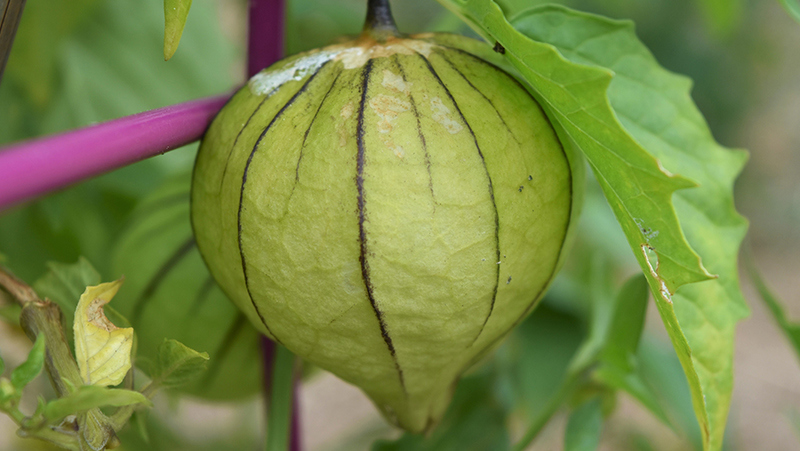Yates Account
Join now
Create a Yates account today!
Sign up to join the Yates Garden Club for monthly e-mails packed with seasonal inspiration, tips for success & exclusive promotions.
Plus if you’re a Garden Club member you can take part in the Yates Growing Community - a blog to share successes, get advice & win prizes in fun challenges along the way!

Forgot password
Enter the email address associated with your account, and we'll email you a new password.

Tomatillo (Physalis ixocarp) is a small edible fruit belonging to the Solanaceae family. A tan to straw coloured calyx covers the fruit and commonly known as “husk tomato.” It is native to Mexico and Guatemala. Ripe tomatillos taste like crisp sweet limes and are excellent raw in fresh salsas or cooked in sauces.
How to grow tomatillo in a garden
- In a sunny spot, fill pots or trays with Yates Black Magic Seed Raising Mix and sow seeds. Firm down and water regularly to keep soil moist. Allow seedlings to grow to about 7 cm height before transplanting.
- Once seedlings have emerged, feed with Yates Thrive Natural Fish Seaweed+ Plant Food Concentrate.
- Prepare the planting area by adding Yates Thrive Natural Blood & Bone with Seaweed to activate the soil microbes. Transplant seedlings and water in well with Yates Thrive Vegie & Herb Liquid Plant Food.
- They can sprawl on the ground or can be staked just like tomato vines.
- Water in well.
- Mulching with organic material like bark chips, pea or lucerne straw helps to ensure moisture retention in the soil.
- Water when required.
- Feed every 6-8 weeks from spring to mid autumn with Yates Thrive Natural Blood & Bone with Seaweed. During flowering and fruiting stages feed weekly with Yates Thrive Natural Fish Seaweed+ Plant Food Concentrate.
- Once the husks or calyx open up as they dry, the fruits are ready to harvest. They usually go dry and turn brown. Harvest them like tomatoes.

How to grow Tomatillo in a pot
- In a sunny spot, fill pots or trays with Yates Black Magic Seed Raising Mix and sow seeds. Firm down and water regularly to keep soil moist. Allow seedlings to grow to about 7 cm before transplanting.
- Choose a pot or trough that is at least 50 cm diameter. Fill with Yates Premium Potting Mix. Add a small amount of Yates Waterwise Water Storage Crystals to the mix. These will help hold extra moisture. Transplant seedlings, backfill with potting mix and water in well with Yates Thrive Natural Fish Seaweed+ Plant Food Concentrate.
- Water when required but don’t let the water sit in a saucer at the base of the pot. Note that staking will be required.
- Add light mulch over the potting mix surface with organic mulch like woodchip or pea straw.
- Feed every 6 weeks with Yates Thrive Natural Blood & Bone with Seaweed. During flowering and fruiting stages feed weekly with Yates Thrive Natural Fish Seaweed+ Plant Food Concentrate.
- Step 6: Once the husks or calyx open up as they dry, the fruits are ready to harvest. They usually go dry and turn brown. Harvest them like tomatoes.
Growing tips
- Tomatillo plants can be very productive. It can produce up to 200 fruits per plant.
- Tomatillos are relatively disease free unlike tomatoes but are prone to pest attack.
- There are a few cultivars available in the market but it is advised to choose a variety that suits the region. Some varieties are:
- 'Cisineros' and 'Gigante' which have big fruit.
- 'Pineapple' has a fruity flavour
- Staking is helpful especially in areas prone to heavy rains as the husks can rot causing damage.
Garlic is known for its many therapeutic uses, but there's no debate; its enduring popularity is because it tastes fantastic. Garlic is a flavoursome addition to any meal.
Spring Onion
The perfect dressing to salads, sides or mains! Here's how you can easily grow spring onions in the garden or pots.
New Zealand Yam
NZ Yams have sweet tasting tubers with a hint of tangy lemon. They’re great for roasting, steaming, stir fries, boiling or mashing; you can use them just like potatoes.
Radishes
Radishes are fast, but healthy food! They grow really quickly and can be ready to pick in just 4 to 8 weeks.
Recommended products
Yates Thrive Natural Blood & Bone with Seaweed
A certified organic garden input boosted with NZ Seaweed to gently nourish plants, enrich the soil and encourage a strong healthy root system.
Yates Thrive Natural Fish & Seaweed+ Plant Food Concentrate
A complete plant food enriched with natural fish, seaweed, humates, molasses and more - boosted with NPK to improve plant and soil vitality.
Yates Premium Potting Mix
A premium potting mix, ideal for all potted plants and shrubs, including ornamentals, fruit trees, vegies and herbs.
Yates Black Magic Seed Raising Mix
Specially formulated for trouble-free seed raising in trays (or outdoor seed sowing direclty into the ground) and propagation of cuttings.
















Share
Share this article on social media